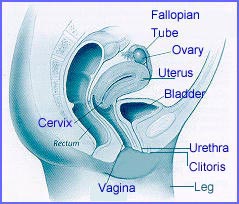Sexual FAQs
![]()
Q. I have been getting Depo-Provera shots for about a year. My periods have stopped totally, what’s up with that?
A. If you’ve gotten your injections on time, the absence of periods does not mean you’re pregnant and is not something to worry about. (The medical term is amenorrhea). In fact, many women like the convenience of not having periods. Without it, women have less menstrual discomfort (such as back pain or cramping) and fewer disruptions of personal activities. Periods usually return within 3 to 10 months after you stop receiving the injections.
Periods stop because DEPO-PROVERA causes a ‘resting state’ in your ovaries. When your ovaries do not release an egg each month, the growth of the lining of the uterus does not occur. So the menstrual bleeding doesn’t occur. You may want your healthcare provider to explain this in more detail.
For more information on Depo-provera, go to their site, no, they don’t pay me to promote it, (wish they did), I just think it is a good choice of birth control for many women.
*=*=*=*=*=*=*=*=*=*=*=*=*=*=*=*=*=*=*=*=*=*
Q. What is Lunelle?
A. Lunelle is a highly effective hormonal contraceptive given as an injection once a month. It is the first in a new class of contraception: the combination long-acting contraceptive.
Lunelle contains a combination of two hormones: medroxyprogesterone acetate (MPA) and estradiol cypionate (E2C). MPA is a progestin and is the same hormone found in Depo-Provera, another injectable contraceptive.
The major difference between Lunelle and Depo-Provera is that Lunelle contains estrogen and Depo-Provera does not. Another difference is that Lunelle only contains one-sixth the amount of MPA found in Depo-Provera. Lunelle also differs from birth control pills in that it contains much smaller doses of estrogen. And unlike the Pill, which must be taken daily, Lunelle only needs to be given once a month. No I don’t get paid to promote either of these. I wish I did! ![]()
*=*=*=*=*=*=*=*=*=*=*=*=*=*=*=*=*=*=*=*=*=*=*=*=*
Q. Where do I put a tampon? Where do I pee out of? Where is my cervix? Which is my clitoris? (These are real questions).
A. This diagram is familiar to us older girls, but I get a lot of questions from guys and gals as to where the urethra and the vagina are located. So, here is a drawing as if your body was sawed in half. (Kind of gross to say that, but this diagram was not my idea, some man many years ago drew it).
Urine is excreted from your bladder by way of the urethra, see the picture. For a guy’s urethra, see the drawing on “Urethritis”. A tampon is inserted into your vagina… see drawing.
Your cervix is at the very top of your vagina and it’s actually part of your uterus. Cervix means ‘neck’, so you may hear that word used in regard to your neck. The cervix protrudes into the vagina, and has a small opening (about the size of a pencil point), through which menstrual fluid escapes. See the pap smear page for more on that.

(For ‘Twink’)
*=*=*=*=*=*=*=*=*=*=*=*=*=*=*=*=*=*=*=*=*=*=*=*=*
Q. How do I insert a tampon? Can a virgin use tampons without breaking her hymen?
A. Yes! And the hymen doesn’t really “break”.
First, READ the instruction sheet that comes in the box of tampons.
To insert a tampon: Slide the applicator into your vagina and then push the plunger, thereby inserting the tampon. First, practice just guiding in the tampon, so that you can find the place and angle for insertion that is comfortable for you. (Use a drop of water to moisten the applicator if that makes it more comfortable for you.) If there is any question about where to insert the tampon — don’t laugh, I get letters about this question all the time — look at the diagram above, or use a mirror to help you. Don’t feel embarrassed about not knowing “which opening is which”, I get asked this a lot and so someone out there needs this information.
As for breaking or not breaking the hymen, does it matter really matter that you have an intact hymen? Hymens come in various shapes and designs. If your hymen is still intact and shaped like a septum (a thin line of skin which divides the center of the vaginal opening, as does the septum of our nose), then this thin membrane of skin may stretch or break when you ride a bike, climb a tree, ride a horse, do gymnastics or do any physical activity. I don’t know why there is so much confusion and myths about the hymen.
Or, if like most females, you have a hymen shaped like a crescent moon around the bottom or sides of the vaginal opening, then tampons should not interfere at all. Or, a woman’s hymen could have already been broken or stretched by sexual activity, even if she has not had a penis inside of her. (And there is your virgin definition. Look up virgin in the dictionary if there is any confusion about what this word really means. I get many letters a week from young teens who don’t understand the definition. Sadly, I guess health education in public schools is not as good as it was when I was a preteen. But you’ve got the net and Teen Health Secrets of course! ![]() * ! * ! Read The Hymen article, it was written after this post, thanks!
* ! * ! Read The Hymen article, it was written after this post, thanks!
